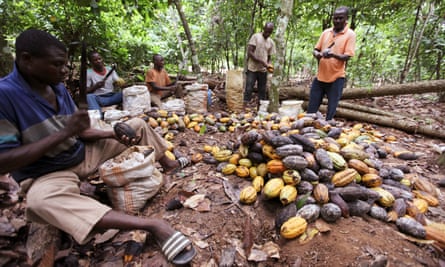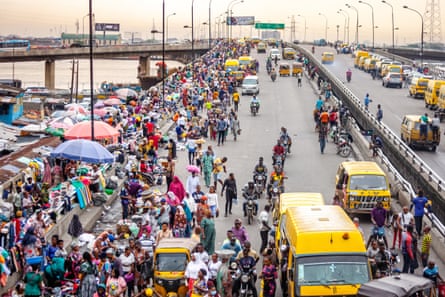An attribution study this week has confirmed the link between the climate crisis and the intense heatwave in the Gulf of Guinea this year, with the heat index reaching 50C (122F) at times. What is the best way to cope with such high temperatures?
Tarly, a 52-year-old carpenter, has seen his colleagues faint due to the heat in his home suburb of Abobo in Ivory Coast in recent months. “The first thing I do when I wake up is shower. But when I get on the gbakka [a popular urban minibus], I’m already sweating, and it stays that way until the afternoon.”
Although he does not have “cooling breaks” at work, he says colleagues occasionally pause to drink coffee or tea.
This year, west Africa was hit by a searing heatwave, with the most severe heat occurring from 11-15 February, and temperatures peaking above 40C and averaging 36C.
 View image in fullscreen
View image in fullscreen
Humidity was also high, making it harder for people to cool down by sweating. The heat index, a measure combining temperature and humidity to reflect how heat feels, reached 50C. “That is very dangerous for the human body,” said Izidine Pinto, a researcher in weather and climate extremes at the Royal Netherlands Meteorological Institute.
Wasiu Adeniyi Ibrahim, an official at the Nigerian Meteorological Agency, said: “The February heatwave happened early in the year, meaning many people would not have been acclimatised to the heat. With every fraction of a degree of global warming, heatwaves like this will become even hotter.”
Globally, last month was the hottest February recorded, the ninth month in a row that such a record has been broken. Carbon emissions, which continue to rise, and the return of the El Niño phenomenon have driven the high temperatures.
Meteorological organisations in Nigeria and Ghana issued warnings about the high temperature but many of the other countries affected did not prepare for dangerous heat.
Maja Vahlberg, a risk consultant at the Red Cross Red Crescent Climate Centre, said: “Many people do not appreciate the dangers of heat [but high temperatures] are silent killers. They can be incredibly deadly for the elderly, people with existing health conditions and outdoor workers. Roughly half of the west African population also lives in informal housing, rendering millions of people highly vulnerable to extreme heat.”
 View image in fullscreen
View image in fullscreen
Farmers in Ivory Coast said in February the high temperatures and lack of rain were damaging crops. In March, cocoa factories in the country, and in Ghana, stopped or reduced processing because they could not afford to buy the beans, Reuters reported. The price of cocoa beans has risen to an unprecedented high of more than $8,000 a tonne, more than three times the price in March 2020.
A study published this week by the World Weather Attribution group of scientists found that the heatwave would have happened less than once a century in a world without the climate crisis. Instead, it was a once-a-decade event, with an average of 1.2C of global heating over the past four years.
The heat affected millions of people but the number of early deaths or cases of illness are unknown, due to a lack of reporting. The WWA report used weather data and climate models to compare the frequency and intensity of the heatwave in today’s heated planet with that in a world without global heating, a well-established methodology used in hundreds of studies.
Tarly’s neighbour found the heat difficult, too. The film-maker Richard Lamah said they had had to adapt their shooting schedules to the temperature.
skip past newsletter promotionSign up to Down to Earth
The planet's most important stories. Get all the week's environment news - the good, the bad and the essential
after newsletter promotion
“We used to shoot from six to nine in the morning, but now it’s impossible because by 9am the sun is scorching,” he said. His colleagues were starting to work in indoor spaces with ventilation as well as “taking breaks to cool off and even taking a shower” in the middle of the shoot.
At home, it was more of the same. “Neither I nor my children sleep well because of the heat; we feel like there’s no air,” he said.
 View image in fullscreen
View image in fullscreen
In Lagos, the most populous city in Nigeria, people continued to struggle with the high temperatures, even after the heatwave eased. Yussuf, a resident, said: “It’s very difficult to work. I feel dehydrated all day, so I have to keep stopping to drink water.”
The heat is affecting his work because he “doesn’t have the same strength to go out for walks”, and his job involves travelling around the country and conducting field visits.
Tarly in Ivory Coast added: “All I can do is open the windows and the door to let the air flow, but even the air doesn’t move.”
He lives with a one-year-old child, who cries at night because he is hot, and his two teenage daughters, who wake up in the middle of the night to shower before returning to bed where they lie in front of the fan. Still, the heat clings; it does not go away.
“At four in the morning, it’s when it’s least hot and you can sleep better, but I have to wake up to go to work,” Tarly said. “When it’s this hot, mixed with humidity, time stands still.”
∎